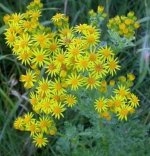Tansy Ragwort
Jacobaea vulgaris
Tansy Ragwort is a short-lived biennial, native to Europe, Asia and Siberia. It can be a perennial and remain in the rosette stage for several years if damage or is under intense competition. It was introduced to Canada in 1850 in ship's ballast and it was also used as a medicinal herb. Often it is spread as a hay contaminant.
This plant contains alkaloids making it toxic to livestock, it causes irreversible liver damage. Although not typically grazed upon the animals can become poisoned by contaminated hay.
Tansy Ragwort is an aggressive plant that can quickly become established on disturbed sites. It prefers areas with full sun to partial shade and well drained soils. It is most commonly found in pastures, hay fields, along roadsides and forest edges.

There can be 1 to several purplish stems that grow up to 1.2 m tall and branch near the top. Leaves are hairy on the underside, dark green in colour and deeply lobed and bluntly toothed. Flowers are numerous and have yellow disk and 13 yellow rays (petals).
The best way to prevent the spread of tansy ragwort is to monitor pastures for new populations. Hand pulling is effective but should be done with care to ensure that all the root has been removed as they can re-establish from root fragments.
Tansy Ragwort is listed as a prohibited noxious weed in the Canadian Seed Act.
Â
Information provided by Alberta Invasive Plant Council
Resources
2011 Rural Municipality Distribution Map
2010 Rural Municpality Distribution Map
Alberta Invasive Plant Council Fact Sheet
Back to Terrestrial Invasive Species List
Â
© Copyright 2004-2024 - CMS Made Simple
This site is powered by CMS Made Simple version 1.4.1



